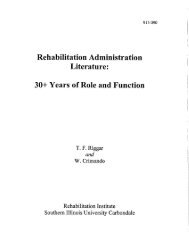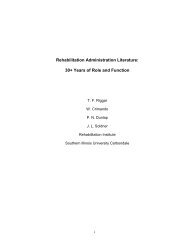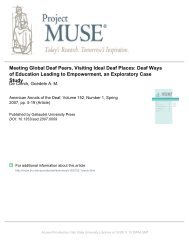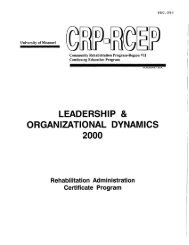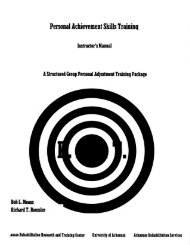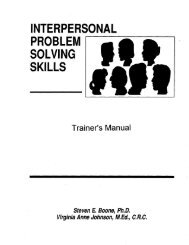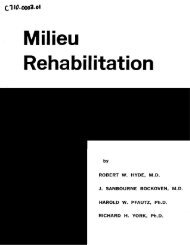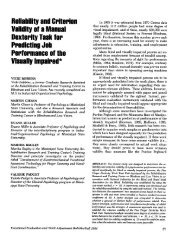by requirements for the degree of (Education) - NCRTM
by requirements for the degree of (Education) - NCRTM
by requirements for the degree of (Education) - NCRTM
Create successful ePaper yourself
Turn your PDF publications into a flip-book with our unique Google optimized e-Paper software.
equired to function successfully on <strong>the</strong> job; whe<strong>the</strong>r or not earnings are<br />
commensurate with <strong>the</strong> individual's abilities; if opportunities <strong>for</strong> advance-<br />
ment exist; and to what extent previous training contributed to job place-<br />
ment. Such a study, particularly if done on an ongoing basis, could <strong>of</strong>fer<br />
data on <strong>the</strong> effectiveness and efficiency <strong>of</strong> VR services and could identify<br />
factors associated with success andfailure. The results would contribute<br />
to improved services and an increased proportion <strong>of</strong> Successful outcomes.<br />
Approximately 30% <strong>of</strong> <strong>the</strong> people closed in competitive employment had<br />
gross earnings <strong>of</strong> $50 or less at time <strong>of</strong> closure. Many <strong>of</strong> <strong>the</strong>se people,<br />
<strong>the</strong>re<strong>for</strong>e, fell below <strong>the</strong> poverty level indicator. The question arises<br />
whe<strong>the</strong>r or not '<strong>the</strong>se people should be closed rehabilitated and VR services<br />
terminated if <strong>the</strong>ir earnings are that low. It would seem that <strong>for</strong> many<br />
<strong>of</strong> <strong>the</strong>se people very serious problems remain. It is interesting to note<br />
that <strong>the</strong>re was little difference between <strong>the</strong> mildly and moderately retarded<br />
in <strong>the</strong> percentages <strong>of</strong> people grouped in <strong>the</strong> various earnings categories.<br />
A follow-up study <strong>of</strong> <strong>the</strong> 159 people who were closed rehabilitated in<br />
employment would be interesting in terms <strong>of</strong> discovering<br />
non-competitive<br />
permanent those situations are, i.e., do many <strong>of</strong> <strong>the</strong> unpaid family<br />
how<br />
workers and sheltered workshop employees eventually acquire competitive<br />
emp 1 oyment ?<br />
An investigation <strong>of</strong> rehabilitated closures could be done to determine<br />
what factors distinEuish those who are competitively employed from thos<br />
who are placed in non-competitive employment.<br />
Fur<strong>the</strong>rmore, a follow-up could be done on those people C144) closed<br />
not rehabilitated prior to acceptance to determine what factors influenced<br />
56% <strong>of</strong> <strong>the</strong>m to refuse services after <strong>the</strong>y applied.<br />
91




